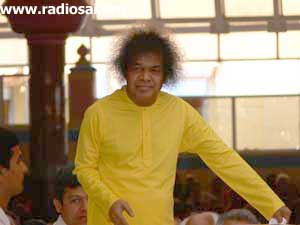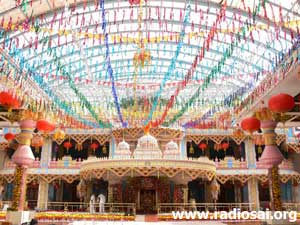



The New year festival or Ugadi ( as it is known in Andhra Pradesh) comes along with Vasant Navratra. The name Ugadi has been derived from Yuga Aadi (Yuga + Aadi means "Beginning of New age"). The ages starting from a major reference point are Golden age, Silver age, Copper age and Iron age and also known in Hindi as Satyuga or Krutha yuga, Treta yuga, Dwapar yuga and Kaliyuga. The very end of Iron age i.e. the Kaliyuga is refer to hell or "Naraka" or the age of ignorance, which our Puranas or even in Srimath Bhagavath Gita mentioned that the Kaliyuga is "the night of the Brahma, the creator of new world and the Satyuga is the Day of Brahma".Ugadi marks the beginning of a new Hindu lunar calendar with a change in the moon's orbit. On this day, people chant mantras and the pundits make predictions for the coming year.
It is believed that the creator of the Hindu pantheon Lord Brahma started creation on this day - Chaitra suddha padhyami or the Ugadi day. Also the great Indian Mathematician Bhaskaracharya's calculations proclaimed the Ugadi day from the sunrise on as the beginning of the new year, new month and new day. The onset of spring also marks a beginning of new life with new plants, shoots and leaves.
Traditionally, on this day the panchangasravanam or listening to the yearly calendar was done at the temples but now one can get to hear the priest-scholar on television sets right in one's living room.
Like any festival it brings with it special recipes and food prepared for this day. "Ugadi pachchadi" is one such dish that has become synonymous with Ugadi. It is made of new jaggery, raw mango pieces and neem flowers and new tanarind which truly reflect life - a combination of sweet, sour and bitter tastes! See the recipe at www.desifoodtv.blogspot.com.
Jaggery represents Krutayuga and Tretayuga which is full of purity, prosperity and peace. Neem leaves represents Dwaparyuga and Kaliyuga which consists of sorrow, chaos and impurity.
The inner significance of Ugadi Pachadi is to indicate that life is a mixture of good and bad, joy and sorrow and all of them have to be treated alike. All experiences have to be treated with equanimity. Every one should make a resolve that he will face calmly whatever happens in this year, accepting it with good grace. Welcome everything. Consider everything as for one’s own good. Men should rise above sorrow and happiness, success and failure. This is the primary message of the Ugadi festival.
Also eaten on this dau id Raw Mango Rice or Mammadikaya Pulihora. In Andhra Pradesh, eatables such as "pulihora", "bobbatlu"( similar to the maharashtrian "puran poli") and other dishes with raw mango are made.
While this festival is called Ugadi in Andhra Pradesh and Karnataka, in Maharashtra it is known as "Gudipadava".
Prior to Ugadi, houses are cleaned thoroughly, new clothes and other puja and festival requirements are bought. On Ugadi day, people wake up before the break of dawn and take a head bath after which they decorate the entrance of their houses with fresh mango leaves.ugadi Pachadi is eaten. Ugadi is also the most auspicious time to start new ventures.
As per legend it is said that Kartik (or Subramanya or Kumara Swamy) and Ganesha, the two sons of Lord Siva and Parvathi were very fond of mangoes. As the legend goes Kartik exhorted people to tie green mango leaves to the doorway signifying a good crop and general well-being.
Another Ugadi tradition has become the Kavi Sammelanam or poetry recitation and is a typical Telugu Ugadi feature.Ugadi Kavi Sammelanam is also a launch pad for new and budding poets. It is generally carried live on All India Radio's Hyderabad "A" station and the Doordarshan,(TV) Hyderabad following "panchanga sravanam" (New year calendar) narrating the way the new year would shape up in the lives of people and the State in general.
Ugadi Subhakankshulu! Wishing you all a great year ahead!
The photos are of a Sammelan, an Ugadi rangoli, Sai Ashram decorated on Ugadi and Sri Sathya Sai's Ugadi darshan.
It is believed that the creator of the Hindu pantheon Lord Brahma started creation on this day - Chaitra suddha padhyami or the Ugadi day. Also the great Indian Mathematician Bhaskaracharya's calculations proclaimed the Ugadi day from the sunrise on as the beginning of the new year, new month and new day. The onset of spring also marks a beginning of new life with new plants, shoots and leaves.
Traditionally, on this day the panchangasravanam or listening to the yearly calendar was done at the temples but now one can get to hear the priest-scholar on television sets right in one's living room.
Like any festival it brings with it special recipes and food prepared for this day. "Ugadi pachchadi" is one such dish that has become synonymous with Ugadi. It is made of new jaggery, raw mango pieces and neem flowers and new tanarind which truly reflect life - a combination of sweet, sour and bitter tastes! See the recipe at www.desifoodtv.blogspot.com.
Jaggery represents Krutayuga and Tretayuga which is full of purity, prosperity and peace. Neem leaves represents Dwaparyuga and Kaliyuga which consists of sorrow, chaos and impurity.
The inner significance of Ugadi Pachadi is to indicate that life is a mixture of good and bad, joy and sorrow and all of them have to be treated alike. All experiences have to be treated with equanimity. Every one should make a resolve that he will face calmly whatever happens in this year, accepting it with good grace. Welcome everything. Consider everything as for one’s own good. Men should rise above sorrow and happiness, success and failure. This is the primary message of the Ugadi festival.
Also eaten on this dau id Raw Mango Rice or Mammadikaya Pulihora. In Andhra Pradesh, eatables such as "pulihora", "bobbatlu"( similar to the maharashtrian "puran poli") and other dishes with raw mango are made.
While this festival is called Ugadi in Andhra Pradesh and Karnataka, in Maharashtra it is known as "Gudipadava".
Prior to Ugadi, houses are cleaned thoroughly, new clothes and other puja and festival requirements are bought. On Ugadi day, people wake up before the break of dawn and take a head bath after which they decorate the entrance of their houses with fresh mango leaves.ugadi Pachadi is eaten. Ugadi is also the most auspicious time to start new ventures.
As per legend it is said that Kartik (or Subramanya or Kumara Swamy) and Ganesha, the two sons of Lord Siva and Parvathi were very fond of mangoes. As the legend goes Kartik exhorted people to tie green mango leaves to the doorway signifying a good crop and general well-being.
Another Ugadi tradition has become the Kavi Sammelanam or poetry recitation and is a typical Telugu Ugadi feature.Ugadi Kavi Sammelanam is also a launch pad for new and budding poets. It is generally carried live on All India Radio's Hyderabad "A" station and the Doordarshan,(TV) Hyderabad following "panchanga sravanam" (New year calendar) narrating the way the new year would shape up in the lives of people and the State in general.
Ugadi Subhakankshulu! Wishing you all a great year ahead!
The photos are of a Sammelan, an Ugadi rangoli, Sai Ashram decorated on Ugadi and Sri Sathya Sai's Ugadi darshan.
No comments:
Post a Comment